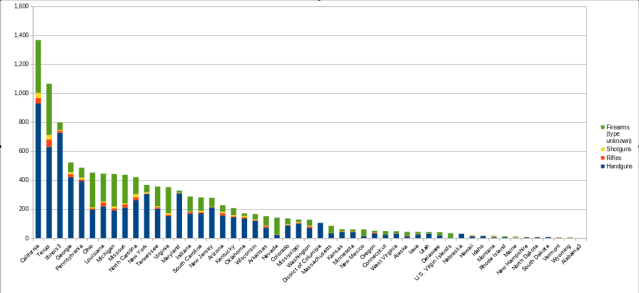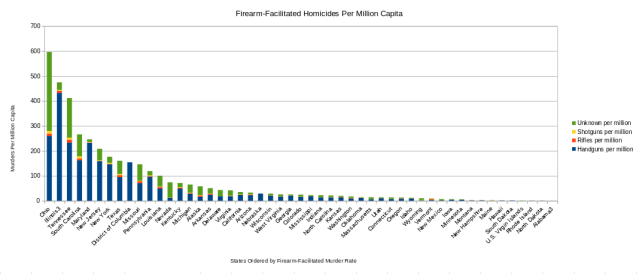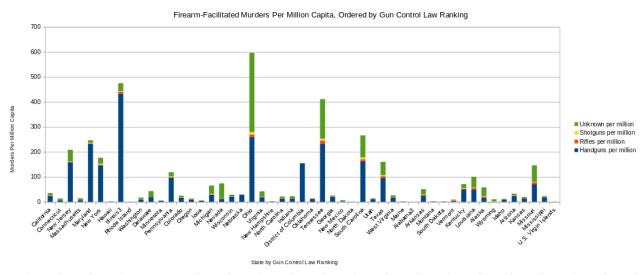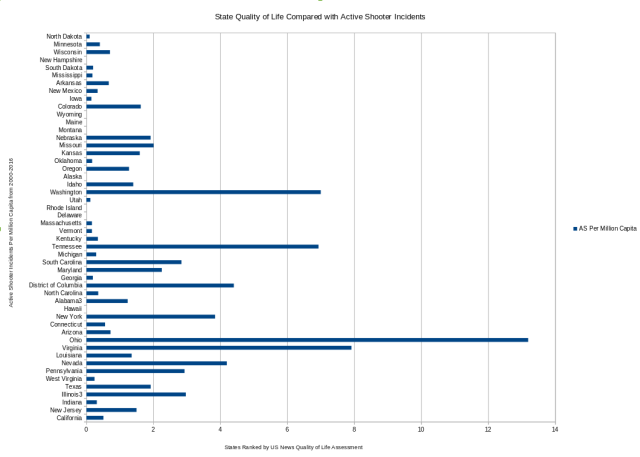So, just to be clear (though it’s not really relevant), I’m a gun owner. I have a single pistol. I don’t really understand why people often seem to own huge numbers of firearms, as it only seems to increase risk and administrative overhead, but whatever. So while I’m not against firearm ownership, I’m also not in favor of keeping firearm laws as they are. I don’t like the nanny state, and I really want to move carefully with such matters, but it does seem to me that firearms are becoming increasingly lethal and, as such, regulation ought to be revisited and adjusted accordingly. We can’t let everyone have Flak Cannons and ASMD Shock Rifles, after all.
I am, however, against false-claim-driven alarmism. Every time a horrifying thing happens, it seems, Americans (especially our media) largely just can’t seem to help themselves from betraying just how poor they are at reasoning under even the slightest degree of duress (which might explain our current President, but I digress..) by immediately demanding agreement with their often ill-informed views and ostracizing those who disagree (which also might explain our current President).
So even though I’ve been greatly enjoying my time away from public discourse, this particular issue is one about which I’m fairly well-informed as a result of my attraction to statistics and reason. This issue, in fact, is a truly excellent example of how statistical sleight-of-hand works and how prevalent it is. Allow me to demonstrate by taking apart a highly representative article from Vox: https://www.vox.com/policy-and-politics/2017/10/2/16399418/us-gun-violence-statistics-maps-charts.
Answers to Obvious Questions Up Front
So, I’ll use 2016 as a benchmark year, here, since it’s the last year for which we have fully processed FBI data. I will consider only homicides for which supplemental data exists; this rules out about 2,000 homicides from consideration, but this will not likely adversely impact the import of the statistical determinations below (except for Alabama, which doesn’t seem to report adequate supplemental data to the FBI).
How many firearm-facilitated homicides occured in the United States during the year of 2016?
- Firearms facilitated 11,004 out of 15,070 total homicides.
- Of those, 435 were justifiable homicides by law enforcement officers.
- Additionally, 331 were justifiable homicides by private citizens.
So:
- 10,338 murders facilitated by firearms took place in 2016.
- Using a population size of 323,127,513, that means any given citizen in the United States, disregarding other relevant factors, has a 0.0031994% chance of being murdered with a firearm each year.
- 331 aggressors were successfully defeated by private citizens in 2016.
What kinds of firearms are used in these murders?

So, immediately, we can see that “assault rifles” aren’t the primary concern, here.
Where do firearm-facilitated murders take place in the United States?

Clearly there is not an even distribution across states. Let’s control for population size to compare rates of such murders’ occurrence between states:

So there’s yer problem areas.
What does that look like if we control for population size and sort states by gun legislation grades given by gun control advocates?
So let’s take the lawcenter.giffords.org scores for those states and sort by that:

Well then. There doesn’t appear to be much of a trend when it comes to tight gun control regulations and firearm-facilitated murders. California, ranked as the best state for gun control legislation, leads the pack in murders. Now, granted, California also has one of the largest population sizes, so let’s control for population size:

So, while California is a lot safer than the absolute numbers make it appear to be, there is still no obvious correlation between gun control stringency and firearm-facilitated murders. In fact, New Jersey, Maryland, New York, and Illinois all have gun control law rankings of B+ or above, and yet, they are four of the top seven states for firearm-facilitated homicide rates.
What About Mass Shootings?
Using the FBI’s definition of an “active shooter” incident (which best describes the kind of event we’re interested in, here; read more below for details), here’s a count (which is presently off by 18 shooting incidents because I had to parse out state counts from an FBI PDF file – I’ll try to fix that later) of incidents in each state, ordered by gun control legislation ratings and normalized on a per-million-capita basis:

Again, according to gun control advocates, one would expect to see a trend in which states nearer to the bottom of the list have greater numbers of incidents, but that does not appear to be the case.
What Qualities Might Best Explain Active Shooter Incidents?
Well, here’s my initial stab at it:

That’s a lot more trendy now, ain’t it? I’m guessing that some better controls and measurements will show a pretty convincing correlation between (my guess: socioeconomic) quality of life and active shooter incidents.
Which is what everyone should expect, really. Everyone should be aware that they’re fighting over the wrong things here. America routinely convinces itself that silly answers to obvious problems should be pursued, when in reality, our quality of life, particularly in terms of the amount of work we do for such little compensation, is diminishing and people are going nuts. We are an extraordinarily wealthy nation which is increasingly dominated by a very, very few gluttons among us, and this is destroying society in many, many ways. Politicians are all too happy to have these distractions bandied about as the primary concern of the American people, ’cause actually addressing the incredible income disparity in America (with the disgustingly gluttonous top 1% of income-earners taking 50% of all income – just think about that) is going to run afoul of their political income generators.
Anyhoo, this section is still a work in progress, so I’ll update it as I have time.
So Back To All Those Misleading Stats…
Now, let’s proceed to scrutinize common claims thrown about in the debate over gun laws:
Claim 1: “America has six times as many firearm homicides as Canada, and nearly 16 times as many as Germany”
The source being used to make this claim is The United Nation’s Office on Drugs and Crimes’ Small Arms Survey, as reported upon by The Guardian.
One initial point to make, though it may be a bit premature, is that statistical sleight-of-hand often occurs by cherry-picking conclusions from separate sources. That is, when one dataset fails to prove an assertion (or even offers evidence against it), simply find another source and use it instead. A good piece of advice is: beware of arguments which make several related points by drawing from entirely different datasets; always ask the question “Why didn’t they just use the same dataset to make that claim?” It’s not that there are never valid reasons to do this, of course, but that it should be a little red flag for you when you see it.
Another sleight-of-hand method often employed (as seen here) is to portray data using an order of magnitude which represents it to suit the argument at hand. The data says that the United States sees 29.7 firearm homicides per million people. That means, excluding all other relevant facts about you, your chance of being murdered by a firearm-wielding assailant on account of your living in the United States of America is 0.00297 out of one hundred, or 0.00297%.
That’s probably a hell of a lot less bad than you thought, eh? It certainly is a lot less bad than I thought it would be before I saw the data, myself.
So, is the number correct? Yeah, it’s probably in the ballpark. Is it alarming given relevant facts about life in the US as compared to the other nations on that list? Call me a pessimist, but I actually think it’s impressively low, myself.
Claim 2: America has 4.4 percent of the world’s population, but almost half of the civilian-owned guns around the world
This is a great example of another pair of common sleight-of-hand methods:
- Use the same queries against datasets of fundamentally dissimilar qualities. You see, we already know that the majority of the world’s citizens don’t have access to firearms in the same way that the United States citizens do. So, asking “How many civilian-owned guns are in the United States” and then “How many civilian-owned guns are in the world?” is a pretty dishonest strategy, as the billions of people living in absolute squalor (and thereby made disproportionately likely to own firearms on that account, alone) by the United States’ living conditions standards are being dishonestly used to drive home a point. Here are some relatively important considerations:
- In many other countries, citizens are explicitly forbidden the right to own firearms. In those countries where weapon ownership is permitted, the citizenry is often comparatively disadvantaged when it comes to the financial capacity and availability of social infrastructure which would permit gun ownership on the same scale as the United States.
- In many other countries (for example, Israel and Sweden), citizens keep firearms at home which are technically owned by the military, and therefore these firearms are discounted from the statistics provided. That doesn’t really help us when it comes to determining whether or not access to weapons drives mass shooting incidents, as these military-owned weapons could just as easily be used in such events.
- Use aggregate numbers to describe distribution where distribution is not normal. When asking the question of how thoroughly firearms are distributed among the American population, one is most likely to intuitively ask a good question: “How many people own guns?” Notice that this question is conspicuously unanswered by the Vox piece. Instead, the figure in Claim 2 is offered: WE HAZ HALF ALL WORLD GUNZ! In reality, only 30% of Americans own firearms. Obviously, many of them have what I would consider to be serious problems (or at least very strange proclivities) and own a huge number of them. At Pew Research (linked above), you can see that about 10% of Americans own more than five firearms. So really, in America, that objective count of civilian-owned firearms does not give a good idea of how proliferate firearms are in America.
Claim 3: There have been more than 1,500 mass shootings since Sandy Hook
Ah, a classic. If you want to be completely intellectually dishonest, use misleading definitions. I will say that I am pleased to see Vox at least admitting that dishonestly in the plain print (despite publishing in bold the misleading claim):
The tracker uses a fairly broad definition of “mass shooting”: It includes not just shootings in which four or more people were murdered, but shootings in which four or more people were shot at all (excluding the shooter).
Even under this broad definition, it’s worth noting that mass shootings make up a tiny portion of America’s firearm deaths, which totaled more than 33,000 in 2014.
(Be sure to read on below about that “firearm deaths” number)
Yes, when discussing “mass shootings” after a gunman has killed 17 people and wounded 15, and including all shootings where four or more people were struck by gunfire, you are being incredibly intellectually honest to the point where your statistic is meaningless. But how dramatic is this intellectual dishonesty? Well, let’s start by establishing a more reasonable defintion of “mass shooting”, like so:
Federal agencies define a mass casualty shooting as the murder of three or more individuals. Due to the rarity of these events, federal agencies do not collect data on mass shootings, but they do collect data on “active shooters.” Active shooter incidents are defined as incidents where “one or more individuals actively engage in killing or attempting to kill people in a populated area.”A This definition does not include gang- or drug-related incidents, the accidental discharge of a firearm, or family- and intimate partner-related shootings
Ok, that sounds more like what we want to know. How many of those incidents occurred in 2016?
Six. From 2000 through 2016, a period of 16 years (including the majority of the timeframe used by Vox’s resource), there have been 220. Vox’s (and basically every major news network’s) intellectual dishonesty is this dramatic. Without looking up the exact difference, I can confidently say the claim that there have been 1,500 mass shootings since Sandy Hook (December 14, 2012) is off by about 1,400 (that’d be an error margin of 93%).
That number proclaimed by Vox includes EVERY INCIDENT wherein four people were struck by gunfire (not even murdered, necessarily). When whittled down to the more reasonable definition of what we understand as a “mass shooting” (that is given by the National Center for Victims of Crime above), it’s down to under 20 per year.
Is that great? No. Is that number rising? Yes. Does something need to be done? Absolutely. Is lying one’s ass off about it one of the things that might plausibly help? No. Is the real data unbelievably staggering for a country of 323 million people where it’s lawful to own firearms? Not even close, in my book.
Claim 4: On average, there is more than one mass shooting for each day in America
As with the above claim, this is obviously an enormous lie. Notice that the only “mass shootings” directly referenced beneath this claim in the Vox article is an actual mass shooting (perpetrated by Dylann Roof). In fact, the kind of shooting which makes up the extreme bulk of the numbers peddled in that article (that’d be the kind where a family member or intimate partner kills multiple relatives and them himself) isn’t even mentioned once. For all their claims to care sooo much, they sure don’t seem to give a crap when it won’t net them those precious, precious Interwebs clicks.
Actual fact: In 2015 (the year shown in the Vox article), there were 20 active shooter incidents (or what we think of when we say “mass shootings”), not 355.
Claim 5: States with more guns have more gun deaths
Well, it looks like the dishonesty continues. Fortunately, perhaps they’re running out of new methods, as this is just another example of using a misleading definition. You see, they now say “gun deaths”. Nice. I’ll give you a single guess as to what driving factor most massively inflates the numbers they will now use.
Yes, it’s suicide. And yes, though we’re talking about mass shootings, Vox is now throwing suicides at you in their numbers. Why? Probably because actual victim counts from mass shootings would make absolutely zero sense when compared with the outrageous counts they’ve offered of those incidents. I guess just using firearms-based homicide counts (see the FBI link below) isn’t impressive enough, so you gotta rope in the suicide rate. It does, after all, roughly double the numbers. Even the CDC is in on this one, using the term “Firearm Mortality” as though they are unaware of the real answer being sought. Finding the actual data from them is proving difficult at the moment (though I believe I saw it before), so I’ll just go with a Time article which cites the figures:
In 2016, there were more than 38,000 gun-related deaths in the U.S. — 4,000 more than 2015, the new CDC report on preliminary mortality data shows. Most gun-related deaths — about two-thirds —in America are suicides
So yeah, firearms-based homicides alone are around 12,000 per year (out of roughly 323,100,000, meaning about 0.0037% of the population is murdered with firearms annually). It’s a lot better for Vox and co.’s arguments if they quietly triple that figure. I mean, it’s still extremely small, but most people don’t seem to do any math, so I guess it works anyway. In fact, given that apparent fact, why do they bother with the deceit, at this point, really?
Whelp, I lasted longer than I thought I would based on my unwillingness to allow dumbassery to persist unabated on the Interwebs (as you can see, I allow myself to indulge in the fantasy that what I say or do here will in any way mitigate said dumbassery), but I think I’m done for now. Maybe I’ll come back and do the rest of these things, but at least I’ve hopefully provided any readers there may be out there with at least an understanding of the gravity and proliferation of this sort of intellectual dishonesty at work in this particular debate. Maybe anyone who was unaware of this (at least specifically how it works) can use this information to provoke future discretion where they may have been too lax in the past.
I dunno, whatever. </rant>
(and yes, I’m leaving my rant stanza malformed on account of lacking an open tag. I’m that done.)
Important Sources:
https://ucr.fbi.gov/crime-in-the-u.s/2016/crime-in-the-u.s.-2016/


Can I strongly suggest that the author of the crock have a look at the the CDC stats for 2013. 11218 deaths by gun homicide makes the rate approximately 3.54 per 100,000. Please also note oh, ill informed author, that that is per year. So now calculate over 70 years of a life and the figure becomse nasty.
I’m not sure what you’re seeing here that I am missing. Perhaps you could help.
A firearm-facilitated homicide rate of 3.54 in 100,000 is equivalent with stating the chance that the average American has of being murdered with a firearm in 2013 is 0.00354%. This means that the average American has a 99.99646% chance of not being murdered with a firearm in 2013. Extrapolating out across 70 years with that probability yields a 99.7525024% chance that the average American will not be murdered with a firearm in a 70-year life. Or, a 0.25% chance that the individual will be murdered with a firearm.
And I presume we’re not excluding justifiable homicides in that statistic.
Now, if we were to be more specific, it is highly probable that the vast majority of locales/life circumstances would yield an even higher likelihood of surviving life in America without being murdered by a firearm. A very few locales/life circumstances would yield a significantly lower likelihood of such survival.
So… not exactly what I would call a “nasty” figure, no?